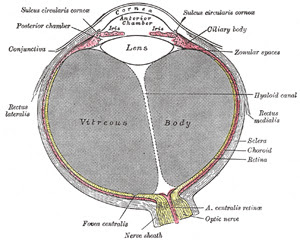by Baxter

A teacher wrote in to ask us about a student who will be having cataract surgery. The teacher said that the student’s doctor told her she should avoid lifting for two weeks, and asked us: “Are there any yoga poses that should be avoided? Inversions come to mind but does that mean downward dog as well?” Because cataract surgery is one of the most common surgeries performed in the US each year, many of us will have students in this very situation, and some us will find ourselves there as well. So I decided to do a full post on the topic.
It is estimated that 50% of adults over the age of 80 have a cataract. Cataract is a clouding of the lens of the eye that lies just behind your pupil and iris, the front and center most parts of your eyeball. The lens allows light and images to pass through to the back of eye onto the retina, which is the part of the eye that sends that image info to the brain. The clearer the lens, the better the image. The lens also focuses the images onto the retina, not unlike the focus feature on a slide projector or movie projector.
What causes the clouding of the lens that we call a “cataract”? The lens is made up of mostly water and proteins. As we get older, some of the proteins begin to clump together. If the clumps get big enough, they begin to partially block the light trying to pass through the lens. As long as the clumps stay small, you may not even notice the changes, but if a clump gets big enough, your vision will start to get blurry or even color tinted, usually brownish. Even though cataracts are sometimes referred to as “age-related” and I mentioned the percentage of elderly with them, you can sometimes develop cataracts in your 40s or 50s, and there are even rare forms of congenital cataracts that infants can be born with. You are at increased risk for developing one if you have prolonged exposure to sunlight, smoke cigarettes, drink alcohol, or have diabetes.
The good news is that treating cataracts with surgery is quite safe in general. However, during the post-surgery period, there are risks of developing problems such as bleeding, infection, or changes in the pressure inside the eye, either up or down. And there is a very slight increase in the chance of the retina at the back of the eye coming away from inside surface of the eye, a condition known as retinal detachment. This last complication is considered a medical emergency as it can lead to sudden loss of vision. To learn more about cataracts in general, check out this National Institutes of Health-sponsored web page Facts About Cataracts.
On the NIH web page, I found the following recommendations for modified activity after cataract surgery, but without specific connection to the above risks:
“When you are home, try not to bend from the waist to pick up objects on the floor. Do not lift any heavy objects. You can walk, climb stairs, and do light household chores.”
I can only assume that these recommendations are made to reduce the risk of bleeding, pressure changes in the eye (which can be position- and exertion-influenced) and retinal detachment. So, how should you modify this student’s yoga practice during the two-week post-operative period, and maybe for a full eight weeks, the typical time for the surgery to completely heal up?
Inversions should certainly be avoided. This includes standing forward bends like Uttanasana and Prasarita Padottanasana, and even Downward-Facing Dog. You can still include modified poses like Half Dog pose at the wall. If you apply the rule of not bending past 90 degrees from vertical, you will minimize the pressure increase to the head and subsequently to the eye. As far as I know, there has not been a specific study to confirm eye pressure changes doing inverted yoga postures, but it seems likely that they would potentially cause it and are therefore best avoided. Also, as I think I have mentioned before regarding yoga and high blood pressure, you also need to limit the length of time you stay in a static or held pose, especially the standing poses, as the exertion required often leads to an overall increase in blood pressure, which could also influence pressures in the eyes. Other rather obvious poses that could have a similar effect are those that require strong, sustained contraction of the abdominal muscles, which would also increase blood pressure in the eyes. Poses like Boat pose (Navasana), deep held twists (even sitting versions), and arm balances like Crow pose (Bakasana) also fall into this category.
In a time of healing—for cataract surgery or any other health recovery time—you want to keep the nervous system quieter, spending more time in the “rest and digest” part of the autonomic nervous system. So spend this two week healing period doing gentler practices, including lots of supported restoratives and guided meditations on health and healing. It would be great to hear back from the person who sent in the question on how things turn out for your student, and from any of our readers who have worked with this situation before.
Follow Yoga for Healthy Aging on Facebook ° To order Yoga for Healthy Aging: A Guide to Lifelong Well-Being, go to Amazon, Shambhala, Indie Bound or your local bookstore.


I would think this would be the same for lasik eye surgery too!
Baxter; quite a few of my students have had cataract surgery or other variations and what I always do is have them get clearance from their opthamologists on their specific yoga limitations. what you wrote is all applicable but some of the local docs are even more conservative so I make sure they get specific clearance on all types of inversions before it is part of their practice again.
Yes, it is advisable to do yoga after your cataract surgery but should be approved by your surgeon. It can be started usually within 2 to 6 weeks..
Having a yoga meditation mindset might be good for lowering blood pressure, even if the trickier yoga poses might increase blood pressure and damage recent cataract surgeries. Eyes are delicate instruments, and blood vessels in them are also delicate, subject to damage by glucose and pressure and poor nutrition.
Paul | myeyespecialist.com.au
my question is can i perform yoga as before after 8 weeks ? or yoga is restricted for life time after cataract surgery
In all likelihood you will be able to, but you should get clearance from your eye surgeon before doing so.
Baxter
Thanks for sharing information. I was not aware about yoga can also be done after cataract surgery. It was a great read.
Great Information, I had no idea of performing yoga after cataract surgery. Cataract is one of the worst enemies of eye. Will let anyone know of this and will make sure they get clearance from their surgeon. Thanks
I’m a student and teacher of yoga who had cataract surgery and went to a yoga retreat the following week. This was after two post surgery visits with my surgeon and his final clearance. I modified a BUNCH (especially with any form of inversion mentioned in the post), moved at my own pace, sometimes did my own thing on the mat, or skipped a class. All classes were moderately paced if not restorative so that helped. The most important thing I did was listen to my body. If you have clearance from your doctor and can let go your ego to give your body some grace and space to move a bit slower, I would say practice. Remember yoga is more than about power poses and powering through a practice.